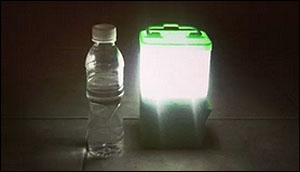This lamp runs on a glass of water and two teaspoons of salt
31. 7. 2015 | ScienceAlert | www.sciencealert.com
An engineering start-up called SALt has invented a lamp that burns for eight hours at a time, running on nothing but a glass of water and two teaspoons of salt.
Named the SALt (Sustainable Alternative Lighting) lamp, the device will also be able to generate enough energy to charge a smartphone via the USB port, while also lighting up the room. The lamp was invented in response to the fact that, right now, there are about 1 billion people in the world who are living without electricity. The SALt lamp works with a galvanic cell battery, which consists of an electrolyte solution - the salt and water - and two electrodes. When the electrodes are placed in the electrolyte, the energy generated kicks an LED light into gear.

According to the developers, the battery will work for eight hours a day for six months. As the majority of the Philippines' 7,000 islands are yet to acquire electricity, the team at SALt decided to initially distribute their lamps to indigenous Filipino communities for wider testing. The design is perfect for these coastal communities, because it works with pure seawater.
The team hopes to get the lamp on the market by 2016, but they'll have some stiff competition with a similar invention also in the works - the GravityLight, which runs simply on the force of gravity. The lamp works a bit like a tiny pulley - all you need to do is add 12 kg of weight to one end of the bead cord, which could be a bag of sand or rocks, for example, and then lift that weight up by pulling down on the lamp that's attached to the other end.
Read mroe at ScienceAlert
Image Credit: SALt
-jk-




